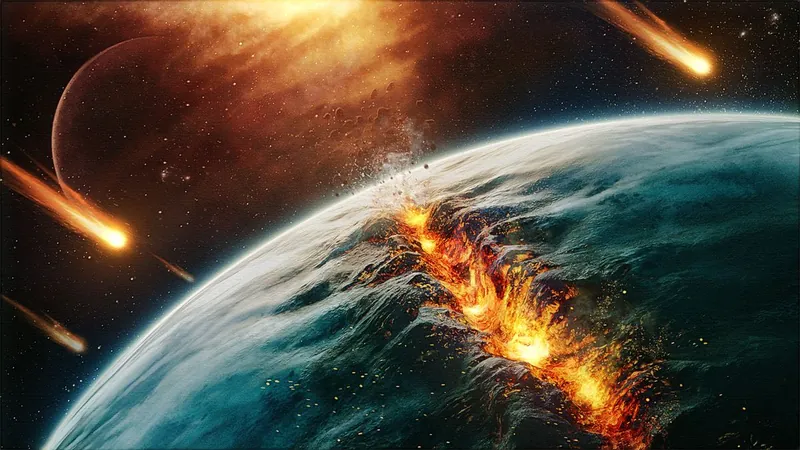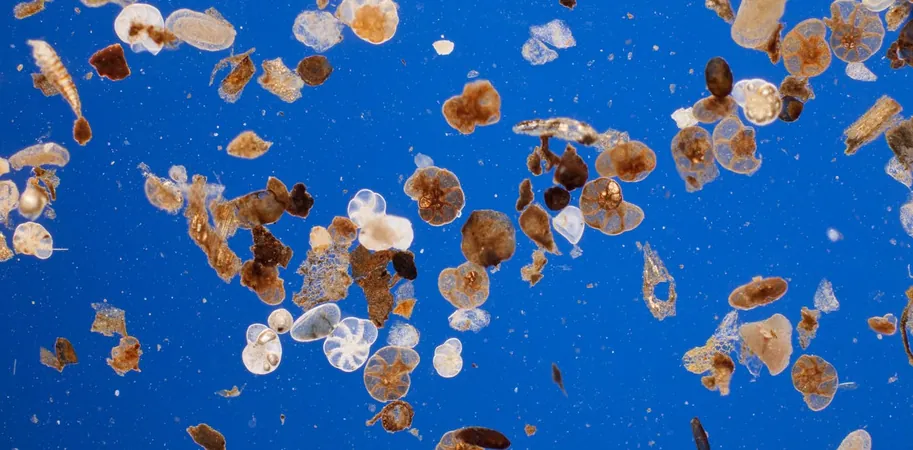
Did Plate Tectonics Spark the Dawn of Life? New Research Delves Into Earth's Most Profound Mystery!
2024-11-08
Author: Sarah
Did Plate Tectonics Spark the Dawn of Life?
Earth's surface is a dramatic realm where mountains rise, continents collide and separate, and earthquakes jolt the landscape. This dynamic activity stems from the phenomenon of plate tectonics — the movement of massive sections of Earth's crust. But could this very movement hold the key to understanding the emergence of life on our planet?
Interestingly, Earth stands alone in the cosmos as the only known planet exhibiting plate tectonics, paralleling its unique status as the only known world to harbor life. Many scientists propose that this correlation is not mere coincidence. The ongoing dance of tectonic plates drags substantial amounts of carbon into the Earth's mantle, stabilizing the climate and allowing life-sustaining minerals and molecules to resurface, creating an environment ripe for life to flourish — from the depths of the ocean to the heights of mountains.
The Mystery of Plate Tectonics and Life's Evolution
However, the origin and timing of plate tectonics remain shrouded in mystery, complicating our understanding of its role in life's evolution. Some researchers suggest that tectonic activities began as recently as 700 million years ago, by which time simple multicellular organisms were already present. Others contend that only single-celled microbes existed on Earth when tectonic processes first emerged.
New techniques in geological analysis have led some scientists to speculate that plate tectonics may have commenced soon after the Earth's formation, possibly even before life appeared. If this hypothesis holds true, it may imply that the simplest forms of life were born on an actively tectonic planet, thereby elevating plate tectonics to a critical factor in the search for extraterrestrial life.
The Role of Plate Tectonics in Life's Development
"The only way we can reliably see a long-term history is on our own planet," states Jesse Reimink, a geoscientist from Penn State University. "We need to fully grasp the life cycle of planetary bodies to inform our research on exoplanets."
Unlike Earth, other rocky planets in our solar system possess rigid, single-layered crusts, which geologists classify as "stagnant lid" tectonics. The jigsaw-like plates of Earth continually reshape the landscape through processes such as mid-ocean ridge formations, where new crust emerges, and subduction zones, where oceanic crust is consumed by the mantle.
Evidence and Challenges in Geologic Activity
Due to Earth's constant recycling of material, evidence for early tectonic activity is scarce. The oldest known oceanic crust is only about 340 million years old, rendering it insufficient to pinpoint the onset of plate tectonics. Most surface rocks, less than 7% are older than 2.5 billion years, and the initial 500 million years — the Hadean eon — leaves no rock record behind.
Significantly, around 3 billion years ago, chemical changes in rocks hinted at increased recycling of crustal materials. This geologic transition phase suggests that the period was marked by a substantial shift in Earth's geological activity.
A Crucial Factor in Life's Evolution
Geoscientists largely agree that, regardless of when tectonics began, it has likely played a crucial role in driving life's evolution and complexity on our planet. Robert Stern, a geoscientist at the University of Texas at Dallas, emphasizes that advanced life forms, such as those capable of engineering spacecraft, require particular conditions that are likely to occur on tectonically active planets.
Notably, plate tectonics has been implicated in facilitating life’s recovery from catastrophic events. For example, after the Permian mass extinction, tectonic activities contributed to re-establishing stable conditions crucial for life to rebound.
Linking Tectonics and the Origin of Life
Some researchers argue that plate tectonics may date back even earlier, possibly influencing the origin of life itself by delivering essential minerals from the Earth’s interior to the surface. This speculation takes scientists back to the Hadean eon, where they rely on hardy zircons — tiny minerals that survived the planet's violent beginnings — to piece together Earth’s ancient geological history.
Recent modeling research indicates that a colossal impact, likely the collision of a planet-sized body that generated the Moon, could have played a pivotal role in initiating subduction processes around 200 million years after Earth formed. This hypothesis raises crucial questions about why Earth is the only rocky planet to exhibit plate tectonics, pointing towards unique historical events as a determining factor.
Implications for the Search for Exoplanets
While the evidence supporting a very early onset of plate tectonics remains tenuous, it opens a fascinating avenue of inquiry regarding how we think about alien worlds. The search for life beyond Earth may ultimately lead us to planets undergoing geological dynamism.
Although we currently lack the ability to detect tectonic movements on distant exoplanets, research conducted on rocky worlds like LHS 3844 b suggests they might possess active mantles and tectonic-like processes. However, this exoplanet, located 49 light-years away, is inhospitable to life as we know it, highlighting the complexities of planetary geology.
Looking Ahead with Advanced Research
As we expand our observational capabilities through advanced telescopes, like the James Webb Space Telescope, understanding nearby planets like Venus may provide invaluable insights into why our planet supports life while its neighbor remains barren.
In summary, as investigations into Earth's tectonic history deepen, the tapestry of life’s origins can become clearer, potentially pointing to the importance of geological activity in nurturing life—not just on our world, but potentially on countless others throughout the universe!




 Brasil (PT)
Brasil (PT)
 Canada (EN)
Canada (EN)
 Chile (ES)
Chile (ES)
 España (ES)
España (ES)
 France (FR)
France (FR)
 Hong Kong (EN)
Hong Kong (EN)
 Italia (IT)
Italia (IT)
 日本 (JA)
日本 (JA)
 Magyarország (HU)
Magyarország (HU)
 Norge (NO)
Norge (NO)
 Polska (PL)
Polska (PL)
 Schweiz (DE)
Schweiz (DE)
 Singapore (EN)
Singapore (EN)
 Sverige (SV)
Sverige (SV)
 Suomi (FI)
Suomi (FI)
 Türkiye (TR)
Türkiye (TR)